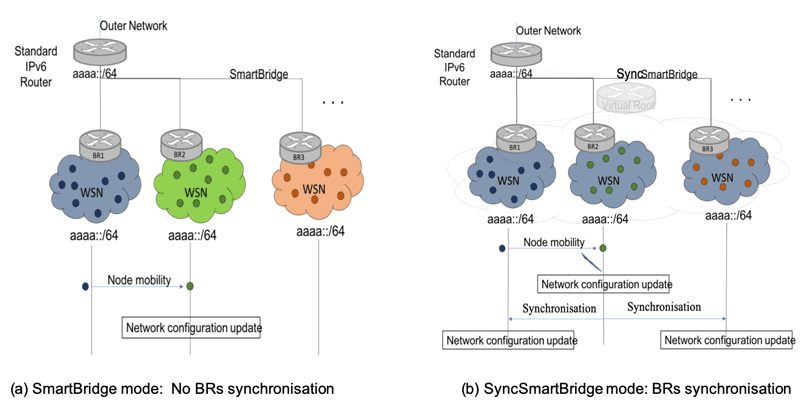by Amel Achour, Lotfi Guedria and Christophe Ponsard (CETIC)
Sensor networks are developing at a fast pace and are facing new challenges such as sensor mobility resulting in topological changes within a network or in adjacent networks with roaming nodes. To address such situations, we are working to extend a reference open source implementation of a border router with extended smart bridge mode.
Today’s world is more connected than ever: both objects of production and everyday objects are connected and exchange information. This raises many challenges for wireless sensor networks (WSN) to ensure the proper quality of service under low power constraints, for example when the sensors are mobile. Surveys have shown that two thirds of applications involve some sort of mobility (e.g. cold chain management, environmental monitoring, vehicle tracking) [1]. Compared with telephony and internet, this problem has received relatively little attention in the literature, and although it has been the subject of ongoing surveys and technological studies like ours, no standard solutions yet exist [2].
Due to their limited resources, sensors are designed to communicate without any infrastructure and each sensor routes packets of his neighbour to reach the border router, which is the gateway between the WSN and the Internet. Modern sensors are smart and can communicate directly with external services resulting in a very large range of applications from smart cities and manufacturing to buildings and home automation. Two types of mobility can be distinguished. Micro mobility refers to sensor movement within the same sensor network domain with no change in the network address prefix. Macro mobility refers to sensor movement to a new sensor network domain with another prefix. Our current scope of work is micro mobility.
To exchange information in a WSN, the RPL protocol (Routing Protocol for Low-Power and Lossy Networks) can be considered [L1]. Since it is designed for lossy networks, it adapts the routing strategies to any topological changes dynamically, meaning it provides implicit mobility support. However, this management is not efficient because it can take a long time to update the topology and reach the new location of a mobile sensor. Our work aims to enhance the global mobility management in the context of RPL-based WSN and increasing the network resilience.
Our proposal is based on 6LBR (6Lowpan Border Router) reference implementation [3] provided in Open Source [L2]. It allows multiple border routers to aggregate WSNs in order to increase resilience. Among the available modes, we consider the smart bridge (SmartBridge) mode where each border router (BR 1 to 3) manages its WSN independently as depicted in Figure 1(a). When a mobile sensor moves from BR1 to BR2, BR2 updates its network configuration and creates new routes so the mobile sensor can communicate in this new location. As BR1 is not aware of this update and the node will stay in its routing table until a timer expiration is reached after several attempts to join it. Our proposal implements a synchronised smart bridge (SyncSmartBridge) mode based on the virtual root principle combined to a synchronisation mechanism. The goal of the virtual root is to provide a unified control plane view of all the concrete WSN within the domain. The synchronisation mechanism will ensure the broadcast of synchronisation triggers to other BRs in order to update their topology and inform them about the new location of the mobile sensor. As shown in Figure 1(b), when a sensor moves from BR1 to BR2, it triggers a network configuration update in BR2. At the same time, BR2 broadcasts a synchronisation message to the other BRs so their topology and the sensor location is immediately updated.

Figure 1: 6LBR based mobility management.
Our protocol design is being validated using the Cooja simulator [L3]. The current work is focused on the scalability, performance assessment and robustness tests through a demonstrator that covers various baseline scenarios: one or multiple sensors moving in same/different directions, simultaneously or randomly. We also plan to consider a combination of more complex mobility scenarios to measure synchronisation delays in situations of high mobility and high network density.
Links:
[L1] https://kwz.me/hES
[L2] https://github.com/cetic/6lbr
[L3] https://anrg.usc.edu/contiki/
References:
[1] J. Wang, et al.: “A survey about routing protocols with mobile sink for wireless sensor network”, Int. J. of Future Generation Communication and Networking, 2014;7(5).
[2] A. Achour, L. Deru, J-C. Deprez: “Mobility management for wireless sensor networks a state-of-the-art”, Procedia Computer Science 52 (2015).
[3] L. Deru, et al.: “Redundant Border Routers for Mission-Critical 6LoWPAN Networks”, Proc. of the Fifth Workshop on Real-World Wireless Sensor Networks, 2013.
Please contact:
Lofti Guedria, CETIC, Belgium
+32 472 56 62 70











